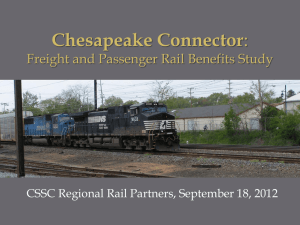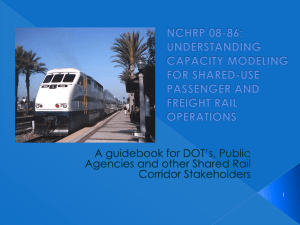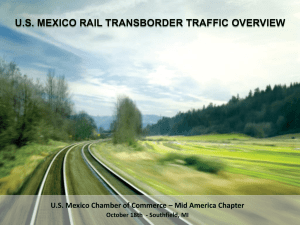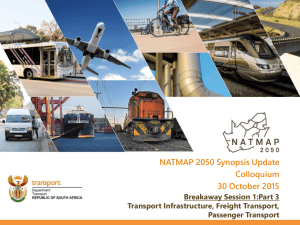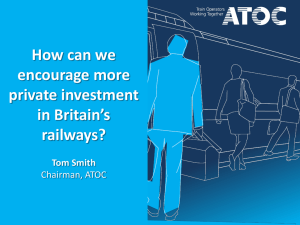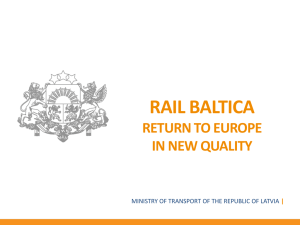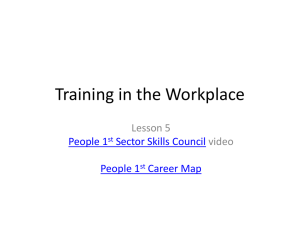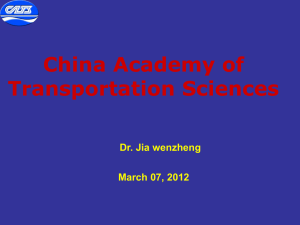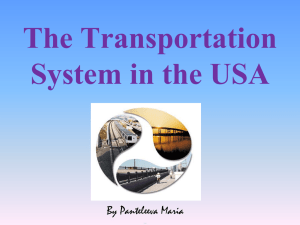State Rail Plan, Minnesota DOT
advertisement
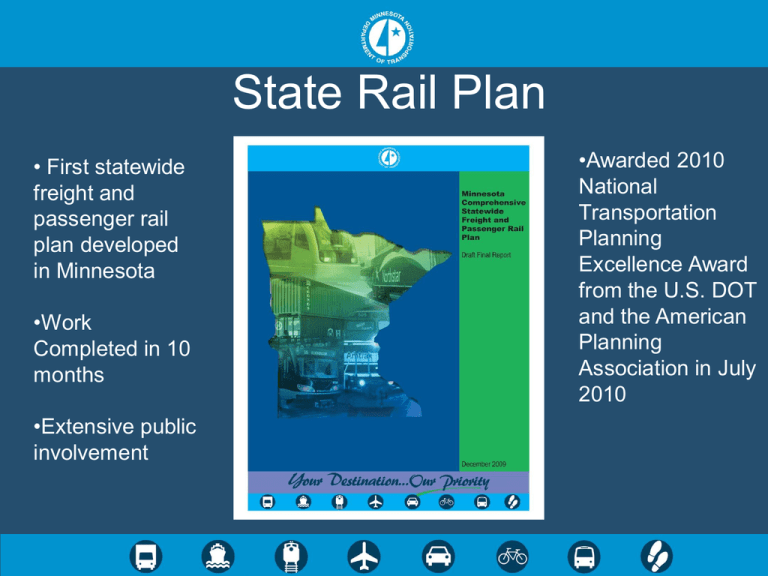
State Rail Plan • First statewide freight and passenger rail plan developed in Minnesota •Work Completed in 10 months •Extensive public involvement •Awarded 2010 National Transportation Planning Excellence Award from the U.S. DOT and the American Planning Association in July 2010 • • • • • First Statewide Comprehensive Rail Plan for MN Commissioned by 2008 Legislature Compliant with 2008 PRIIA Federal Rules 6 Months to prepare, 10 Months to develop Plan Most significant outreach and public review ever incorporated: 4 rounds of Open Houses, Policy Advisory Committee with unlimited membership, Freight and passenger technical committees, and continuous communications maintained throughout for input Freight Vision • Rail is a critical part of the state’s multimodal freight system, and provides connections to key markets beyond the state • Many of the state’s major industries rely on freight rail • A strong rail system supports – Economic development – Environmental sustainability – Preservation of the publicly owned roadway infrastructure – Business marketability of the State • Therefore, Minnesota should strive to develop a balanced multimodal freight system which can respond to increased regional and international economic competition, constrained highway capacity, environmental challenges, a diverse customer base and rising energy costs 3 Passenger Vision • Forecast shows population and employment growth in the state will continue to increase demand on the state’s highway, air, bus systems • Availability of new federal funds for rail investment creates a unique opportunity • Global and national economic and environmental trends are likely to increase fuel costs and impose controls on greenhouse gas emission • Therefore, Minnesota should develop a robust intra- and interstate intercity passenger rail system which results in improved travel options, costs, and speeds for Minnesota and interstate travelers Accomplishing the Passenger Vision • Develop HSR service with Mid West Regional Rail Initiative to connect the Twin Cities to the Chicago Hub Network • Develop a regional passenger rail network connecting the Twin Cities to major regional trade centers, coordinated as part of a larger integrated regional/national multimodal system • Use interchangeable and interoperable equipment, common facilities, fully coordinated routes, schedules in network • All corridors serve state and full Metro area connected through the Minneapolis downtown terminal and St. Paul Union Depot • Advance system incrementally to develop network connectivity and grow ridership in timely manner • Advance projects simultaneously depending on readiness, funding, ROW acquisition, agreements with freight RRs Phase I Projects (2010-2030) Phase II Projects (Future Expansion) Other Freight Lines Types of ServicesConventional Passenger: Up to 79 MPH, Comingled with Freight (Amtrak, 403b) Intermediate High Speed: 90-110 MPH, upgraded track and ‘sealed’ corridor (Harrisburg, Detroit) True High Speed: 150+MPH, segregated corridor (Bullet, TGV) Principles For HSR Success: • Frequency - more trains, more choice • Travel Times – Twin Cities to Chicago at 110 Mph, > 5 Hrs; at 180 Mph, > 3 Hrs • Access – Key station locations, direct urban service • Connectivity – Regional Mobility - Varied train services; locals, express, overnights - Bus feeders and transit hubs - Direct airport links • Amenities – Trains, stations, connections Rail Improvement Benefits • High speed passenger rail, 100-500 mile length, offers improved travel time, capacity, reliability, predictability in major corridors • Positive benefits for energy use, environmental impacts, economic development, jobs, land use, modal and transit connections • Positive return on investment, 1.5-2.5 times more than cost • Bridge, bottleneck, track upgrades to handle 25 mph/286K freight minimums, HSR system improve MN competitiveness • Improving rail options, expanding intermodal capacity saves roads & complements capacity of road, waterway, air, and public transit systems Estimated System Costs & Revenues (Phase I passenger & freight system – 2009 $) • • • • • • • Total system capital investment by 2030 = $6.2-9.5B Freight portion of total = $2.2-4.5B – 74% private Passenger portion of total = $4.0-5.1B – 50-80% Federal Annualized non-federal share = $78-180M Gross Annual Operating cost = $143-182M After farebox revenues, annual subsidy = $41-95M Farebox recovery ratio = 48-69% Initial Results of Plan • • • • • • Minnesota Passenger Rail Forum convened Mn/DOT Office of Passenger Rail formed $26 Million Passenger Rail bonding passed Partnership with State of Wisconsin Federal grants for St. Paul Union Depot, MWRRI planning Plan adoption, 2/9/2010, signals Mn/DOT transition to multimodal transportation department Long Range Targets • More transportation capacity & choices • Reduced travel times and costs, and increased convenience for large share of population • Increasing rail mode share in key corridors • Enhanced usefulness of all public transportation modes, incl. transit, bus, air • Reduced or eliminated operating subsidies as ridership increases • Better economic competitiveness for region • Improved environment, energy use, national security Current Ongoing Projects • • • • • • • • Governance and Funding Study* Coordinated Commuter/Intercity Opns. Study* St. Paul Union Depot East Metro Freight Capacity Study Northern Lights Express Milwaukee-Twin Cities HSIPR Study Rochester Area Freight Capacity Analysis Downtown-To-Downtown Capacity Study FRA Guidance and Cooperation • Project Statement Of Work and justification • Grant Applications • Freight Capacity Improvement: Planning and Railroad Agreements an absolute requirement (PRIIA) • Foresight in Construction Phasing, Design required – cannot preclude future expansion or improvement • Detailed Service Development Plan – minimize risk • Satisfy All NEPA and regulatory mandates Evolution of the Program • Freight rail is growing (2%/year)-rail lines are not public, and they are not free! • Passenger rail can be effective (France, Japan, Northeast Corridor, VRE, GO Transit) • Passenger rail DOES NOT need to pay for itself (think roads): It DOES need long-term operating, funding commitments (tangible public benefit) • HSIPR programmatc support – Re-authorization
